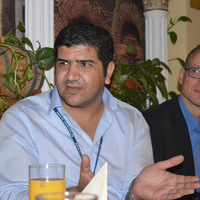Khaled Khalyfeh
TU Chemnitz, Chemistry, Undergraduate
The spectroscopic characterization (1H, 13C{1H} NMR, UV–Vis) and single-crystal X-ray diffraction (scXRD) analysis accomplished by inspection of the Hirshfeld surface of bis(3-thienoyl) disulfide (1) is described. The title compound 1... more
The spectroscopic characterization (1H, 13C{1H} NMR, UV–Vis) and single-crystal X-ray diffraction (scXRD) analysis accomplished by inspection of the Hirshfeld surface of bis(3-thienoyl) disulfide (1) is described. The title compound 1 crystallizes in the monoclinic space group P21/n. The unit cell parameters are a = 7.9959(3) Å, b = 6.4348(3) Å, c = 22.4924(9) Å, β = 100.108(4)°, V = 1139.32(8) Å3, Z = 4, Rgt(F) = 0.0278, wRref(F2) = 0.0667. The packing of 1 is dominated by S⋯O and S⋯S interactions, giving a 2D layer structure parallel to (101). The X‐ray crystal structure analysis revealed the packing of 1 is dominated by S⋯O and S⋯S interactions, giving a 2D layer structure parallel to (101). The intermolecular interactions in 1 were analyzed using the Hirshfeld surface method including 2D fingerprint plots and enrichment ratios (E), which shows that the most favored intermolecular contacts are the O⋯H and C⋯S indicated by E values above 1.30. The interaction energies between mole...
Research Interests:
Abstract The reaction of [Fe(η5-C5H4CH2OH)2] (1) with 2 equiv of ClC(O)R (2) (a, R = C6H5; b, R = 2-CH3-C6H4; c, R = 3-CH3-C6H4, d, R = 4-CH3-C6H4) produced the corresponding ferrocenyl carboxylates [Fe(η5-C5H4CH2OC(O)R)2] (3a–d).... more
Abstract The reaction of [Fe(η5-C5H4CH2OH)2] (1) with 2 equiv of ClC(O)R (2) (a, R = C6H5; b, R = 2-CH3-C6H4; c, R = 3-CH3-C6H4, d, R = 4-CH3-C6H4) produced the corresponding ferrocenyl carboxylates [Fe(η5-C5H4CH2OC(O)R)2] (3a–d). Treatment of [FcCH2OLi] (4-Li) (Fc = Fe(η5-C5H5)(η5-C5H4)) with (ClC(O))2C6H4 (5) (a, 1,2-((ClC(O))2-C6H4; b, 1,3-((ClC(O))2-C6H4; c, 1,4-((ClC(O))2-C6H4) in a 2:1 M ratio gave (FcCH2OC(O))2-C6H4 (6a–c), while with 1,3,5-(ClC(O))3-C6H3 (7) in a 3:1 M ratio produced 1,3,5-(FcCH2OC(O))3-C6H3 (8). All compounds were characterized by NMR (1H, 13C{1H}) and IR spectroscopy, ESI-TOF mass spectrometry and elemental analysis. The molecular structures of 3a–d and 6b in the solid state were determined by single crystal X-ray structure analysis, showing anti-periplanar orientations of the 1,1′-positioned substituents at ferrocene (3a–d). In the cyclic voltammograms of 3a–d, 6a–d and 8 reversible electrochemical redox processes (Fc/Fc+) were observed, ranging between 146 and 164 mV for 3a–d, ca. 100 mV for 6a–d and at 113 mV for 8 using [NnBu4][B(C6F5)4] as the supporting electrolyte. The molecular electronic structure of 3, 6 and 8 was calculated by DFT methods in order to obtain the HOMO and LUMO absolute and relative energies in addition to electron density and distribution within the molecular arrangements. It was found that different degrees of HOMO-LUMO energy gaps within the series, due to a lowering in the LUMO energy depending on the positions of the carboxylic ester substituents on the aryl rings, are in agreement with the electrochemical results obtained.
Research Interests:
Research Interests:
Abstract Ferrocenes with up to four formyl functionalities have been synthesized by selective one- or two-fold ortho-lithiation of 1,1′-di(1,3-dioxan-2-yl)ferrocene followed by the reaction with dimethylformamide. Subsequent deprotection... more
Abstract Ferrocenes with up to four formyl functionalities have been synthesized by selective one- or two-fold ortho-lithiation of 1,1′-di(1,3-dioxan-2-yl)ferrocene followed by the reaction with dimethylformamide. Subsequent deprotection afforded tri- and tetraformyl-ferrocene in good yields. Wittig reactions convert the aldehydes to tri- and tetravinyl-ferrocene. The structures of three formyl-ferrocenes in the solid-state have been determined by single crystal X-ray diffraction. In two of the structures the ferrocene moieties form 1D chains by parallel displaced π-interactions with Cp⋯Cp distances as short as 3.21 A. Electrochemical measurements (CV) demonstrated an irreversible behavior of the electron-poor multi-formyl ferrocenes. Reducing the measurement temperature down to −40 °C and the usage of [NnBu4][B(C6F5)4] prevents side reactions and hence reversible redox-processes could be obtained. It was found that the number of formyl functionalities correlates with the ferrocenyl's redox potential in a strictly linear fashion.
Research Interests:
Research Interests:
Treatment of 1,4-(SeSiMe 3 ) 2 -C 6 H 4 ( 1 ) with two equiv of ClC(O)R ( 2 ) ( a , R = 2- c C 4 H 3 O; b , R = 2- c C 4 H 3 S; c , R = 3- c C 4 H 3 S) produced the corresponding phenylene carboselenolates 1,4-(SeC(O)R) 2 -C 6 H 4 ( 3a –... more
Treatment of 1,4-(SeSiMe 3 ) 2 -C 6 H 4 ( 1 ) with two equiv of ClC(O)R ( 2 ) ( a , R = 2- c C 4 H 3 O; b , R = 2- c C 4 H 3 S; c , R = 3- c C 4 H 3 S) produced the corresponding phenylene carboselenolates 1,4-(SeC(O)R) 2 -C 6 H 4 ( 3a – c ), while the reaction of 1,4-(SLi) 2 -C 6 H 4 ( 4 ) with ClC(O)R ( 2 ) in a 1:2 molar ratio gave phenylene carbothiolates 1,4-(SC(O)R) 2 -C 6 H 4 ( 5a – c ). Compounds 3a – c and 5a – c were characterized by elemental analysis, NMR ( 1 H, 13 C{ 1 H}, 77 Se{ 1 H}) and IR spectroscopy. The molecular structures of 3a – c and 5a – c in the solid state were determined by single-crystal X-ray structure analysis. The carbochalcogenato groups and the heteroatoms of the 5-membered rings are in an anti -arrangement with respect to each other. Cyclic voltammetry measurements show irreversible reduction processes for the 5-membered heterocyclic redox moiety in which reduction of these compounds lead to decomposition of the original compounds to unidentified s...
